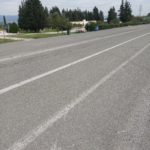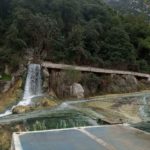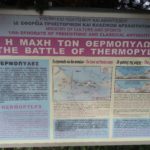Have you ever wondered if it’s possible to visit one of the most iconic battlefields in history? Look no further than Thermopylae, the site of the legendary Battle of Thermopylae in 480 BC.
Embark on a journey through time and explore the historical significance of this ancient battlefield. Discover the heroic stand of King Leonidas and his Spartan warriors against the Persian army led by Xerxes.
From the monuments and memorials that commemorate the battle to the Thermopylae Museum, there are plenty of opportunities to learn about this epic saga. Plan your visit today and immerse yourself in the rich history of Thermopylae!
Key Takeaways
- Thermopylae is an ancient battlefield where the Battle of Thermopylae took place in 480 BC.
- King Leonidas and his Spartan warriors famously held off the Persian army led by Xerxes in an epic stand.
- There are monuments and memorials at Thermopylae that commemorate the battle.
- The Thermopylae Museum offers exhibits and artifacts that provide insights into the ancient world.
- Plan your visit to Thermopylae and explore nearby attractions, accommodations, and dining options.
The Ancient Battlefield of Thermopylae
The ancient battlefield of Thermopylae holds a significant place in Greek history, serving as a site of numerous battles and strategic importance for centuries. Its location, nestled between mountains and the sea, made it a natural defense point for Greek city-states.
The name “Thermopylae” translates to “hot gates,” a reference to the natural hot springs in the area. It was here that the famous Battle of Thermopylae took place in 480 B.C., during the Persian Wars.
“Spartans, why don’t you come and get them?” – King Leonidas, urging his warriors to face the Persian army
The Greeks, led by King Leonidas of Sparta, fought valiantly against the massive Persian army, which included soldiers from across the vast Persian Empire. Despite being vastly outnumbered, the Greeks held off the Persians for three days before ultimately succumbing to enemy forces.
The Battle of Thermopylae was a pivotal moment in Greek history, not only for its military significance but also for the bravery and sacrifice of the Spartan warriors. Today, Thermopylae serves as a symbol of Greek courage and resilience in the face of adversity.
The Historical Context of Thermopylae
Thermopylae played a crucial role in Greek history before and after the famous battle. It was a significant spot for trade and commerce, connecting northern and southern Greece. It also served as a barrier between the Thessalian plain and southern Greece, making it a vital defense point.
Throughout history, Thermopylae was the site of numerous battles, including those fought during the Greco-Persian Wars, the Corinthian War, and the Roman-Seleucid War. The location’s strategic importance continued through the Byzantine and Ottoman periods, as well.
Today, the ancient battlefield of Thermopylae is a must-see site for anyone interested in ancient history, military strategy, and the legacy of Greek civilization.
The Battle of Thermopylae: An Epic Saga
The Battle of Thermopylae is one of the most famous battles in history, a true epic saga of heroism and sacrifice. In the summer of 480 BC, King Leonidas and his Spartan warriors faced off against the massive Persian army led by King Xerxes. Although vastly outnumbered, the Greeks fought fiercely and held back the Persians for three days.
“Spartans, why don’t you come and get them?”
— King Xerxes taunting the Spartans to surrender their weapons before the Battle of Thermopylae
The Greeks’ strategy involved using the narrow pass at Thermopylae to their advantage, making it difficult for the Persians to use their superior numbers. The famous 300 Spartans led the charge, but they were not alone. The Greek force included warriors from other city-states and was estimated to be around 7,000 to 8,000 strong.
The Persian army, on the other hand, is said to have numbered around 100,000. Despite their overwhelming advantage, the Persians were unable to break through the Greek defenses for three days.
However, on the fourth day, a traitor named Ephialtes showed the Persians a secret path that led behind the Greek lines. This betrayal ultimately led to the defeat of the Greeks, including the death of King Leonidas and all 300 Spartan warriors who had fought so bravely.
The Battle of Thermopylae was a defining moment in Greek history, representing the ultimate sacrifice for one’s country and the importance of standing up to tyranny. Today, the battle remains a symbol of courage and valor, inspiring countless books, movies, and other works of art.
The Legacy of the Battle of Thermopylae
The Battle of Thermopylae may have ended in defeat for the Greeks, but it was the beginning of the end for the Persian invasion. The Greeks went on to win the naval Battle of Salamis and eventually defeated the Persians in the Battle of Plataea.
Moreover, the sacrifice of King Leonidas and his warriors has become a symbol of Greek resistance against foreign invaders. The battle has become ingrained in Greek identity and folklore, often used as a rallying cry for national unity and pride.
The Battle of Thermopylae’s legacy has transcended time, celebrating the power of standing up for what is right, even when the odds are stacked against you.
Preserving History: The Monuments of Thermopylae
At Thermopylae, preserving history is not just an idea, but a tangible practice. Visitors to this ancient battlefield can behold the numerous monuments erected in honor of the warriors who fought and fell here.
“Go tell the Spartans, stranger passing by, that here, obedient to their laws, we lie.”
Perhaps the most famous monument at Thermopylae is the Leonidas Monument. This statue of King Leonidas stands proudly on a hill overlooking the battlefield, reminding visitors of the bravery and sacrifice he and his 300 Spartan warriors made. Other monuments include the plaques that adorn the entrance to the battlefield, marking the spot where the Greek and Persian forces clashed.
Together, these monuments stand as testaments to the courage and sacrifice of those who fought and died at Thermopylae. They serve as reminders of the power of history to inspire and move us, even thousands of years after the fact.
Exploring the Thermopylae Museum
Step into the past and immerse yourself in the history of the Battle of Thermopylae at the Thermopylae Museum. This modern museum, located near the battlefield site, showcases a stunning collection of artifacts and exhibits that offer insights into the ancient world.
The Thermopylae Museum features weapons, armor, and other archaeological finds that provide a glimpse into the strategic planning and tactics of the Spartan warriors. Visitors can also admire the stunning sculptures and learn about the myths and legends that have shaped Greek history.
“The Thermopylae Museum is a must-see attraction for anyone interested in ancient history. The exhibits are expertly curated, and the artifacts are truly remarkable!” – Maria S., Athens
In addition to the permanent collection, the museum hosts temporary exhibitions that explore various aspects of Greek history and culture. Interactive displays allow visitors to engage with the exhibits and gain a deeper understanding of the significance of the Battle of Thermopylae.
Virtual Tour of the Thermopylae Museum
If you can’t visit the museum in person, fear not! The Thermopylae Museum offers a virtual tour, allowing you to explore the exhibits from the comfort of your own home. Experience the thrill of walking through the halls of the museum and learning about the ancient world through state-of-the-art technology.
Embark on a journey of discovery and exploration today! Plan your visit to the Thermopylae Museum or take a virtual tour to delve into the fascinating history of the Battle of Thermopylae.
Accessing Thermopylae: How to Get There
Thermopylae is located in the region of Central Greece, making it easily accessible by various modes of transportation.
If you’re traveling by car, take the Athens – Lamia highway and follow the signs to Thermopylae. The distance from Athens is approximately 200 km, and the journey takes about 2.5 hours.
For those who prefer public transportation, a train from Athens to Lamia is available, and there are regular bus services from Lamia to Thermopylae. Alternatively, organized tours by bus are also available from Athens.
Once you arrive, there is ample parking space available near the battlefield site.
Pro Tip: We recommend visiting Thermopylae during the early morning or late afternoon to avoid the crowds and enjoy a more peaceful experience.
Exploring Nearby Attractions
While in the region, don’t miss the chance to explore the nearby attractions and experience the true beauty of Central Greece. Visit the nearby hot springs of Kamena Vourla for a relaxing dip in warm waters or discover the ancient history of the neighboring city of Lamia.
There are also several charming villages in the area, such as Amfikleia and Makrakomi, that offer a glimpse into traditional Greek life and culture.
Accommodation and Dining Options near Thermopylae
If you’re planning to stay overnight, there are several accommodation options near Thermopylae, ranging from budget-friendly to luxurious. The closest town with accommodation options is Lamia, located approximately 40 km away.
For dining, there are several restaurants and cafes in the area, serving traditional Greek cuisine and delicacies. We recommend trying local specialties such as moussaka, souvlaki, and fresh seafood.
Plan Your Visit to Thermopylae Today!
Now that you know how to access Thermopylae and what to expect in the surrounding area, it’s time to plan your visit to this iconic battlefield and experience history firsthand. Whether you’re a history buff or simply curious, a visit to Thermopylae is an unforgettable journey through time.
Exploring Nearby Attractions
While Thermopylae is undoubtedly the highlight of any visit to the region, there are many nearby attractions worth exploring.
Just a short drive away, you can visit the hot springs of Kamena Vourla and enjoy the therapeutic waters that have been sought after for centuries. Or, head to the town of Lamia to see the ancient ruins of the city which was founded around 3,000 years ago.
If you’re interested in mythology, a visit to Mount Oeta is a must-see. According to legend, this was the site of Hercules’ death and the place where he ascended to immortality. The stunning views from the mountain are worth the trek.
Other Nearby Attractions:
- Thermopylae Monument
- Thermopylae Museum
- Delphi Archaeological Site
- Meteora Monasteries
Whether you’re a history buff or a nature lover, there’s something for everyone in the region surrounding Thermopylae. Take a day trip or extend your stay to discover the many wonders of this corner of Greece.
Accommodation and Dining Options near Thermopylae
If you’re planning a visit to Thermopylae, you’ll need to consider your accommodation and dining options. There are a variety of options to suit all budgets and preferences, from luxurious hotels to cozy guesthouses.
Accommodation near Thermopylae
For those seeking a luxurious experience, the nearby town of Kamena Vourla offers a range of five-star hotels and resorts. The area is known for its natural hot springs, making it an ideal destination for relaxation and rejuvenation.
If you’re on a budget, there are also plenty of affordable options, such as guesthouses and hostels in the nearby town of Lamia. These accommodations offer a more authentic experience, allowing you to immerse yourself in the local culture and way of life.
No matter where you choose to stay, be sure to book in advance during peak season to ensure availability.
Dining options
After a day exploring the battlefield, you’ll want to indulge in some delicious Greek cuisine. Fortunately, there are plenty of dining options in the area, ranging from traditional tavernas to modern restaurants.
For a taste of authentic local cuisine, head to the town of Lamia and explore the winding streets and alleyways. You’ll find cozy tavernas offering homemade dishes made from fresh, local ingredients.
If you’re looking for a more upscale dining experience, the nearby town of Kamena Vourla is home to several fine dining restaurants with stunning sea views.
Regardless of where you choose to eat, be sure to try the local specialties, such as moussaka, souvlaki, and fresh seafood.
With so many accommodation and dining options near Thermopylae, you’re sure to find the perfect combination to suit your needs and preferences. Book your trip today and embark on a journey through history and culture!
Plan Your Visit to Thermopylae Today!
Now that you have learned about the ancient battlefield of Thermopylae and the famous Battle of Thermopylae, you may be wondering how to plan your visit to this historic site.
Accessing Thermopylae is relatively easy, with various transportation options available. If you’re traveling by car, you can reach Thermopylae by taking the Athens – Lamia National Road and following the signs to Thermopylae. Alternatively, you can reach the site by train or organized tours.
During your visit, you can explore the monuments and memorials that commemorate the battle, including the famous Leonidas Monument. Additionally, don’t miss the Thermopylae Museum, which houses a wide range of artifacts and exhibits that bring the history of the Battle of Thermopylae to life.
Exploring Nearby Attractions
If you have the time, consider exploring the nearby attractions and points of interest in the region. For example, you can visit Kamena Vourla and enjoy the hot springs or explore the ancient city of Lamia. These additional historical and natural wonders in the area are well worth the visit.
Accommodation and Dining Options near Thermopylae
You’ll also find a variety of accommodation options near Thermopylae, ranging from hotels to guesthouses. Some of the recommended options include the Hotel Oiti, the Diolkos Studios, and the To Limeri tou Sotiriou Guesthouse.
When it comes to food, you can savor traditional Greek cuisine at local restaurants such as Taverna Klimataria and Mourga Tou Moria. Be sure to try local delicacies like moussaka, pastitsio, and souvlaki.
Visiting Thermopylae is more than just a trip to a famous battlefield. It’s an opportunity to experience history firsthand and walk in the footsteps of ancient heroes. So, plan your visit to Thermopylae today and discover the transformative power of exploring iconic battlefields and epic sagas.
FAQ
Is it possible to visit Thermopylae?
Yes, Thermopylae is open to visitors who wish to explore its historical significance and learn about the iconic Battle of Thermopylae.
What is the historical context of Thermopylae as an ancient battlefield?
Thermopylae holds great historical significance as it was the site of a major battle between the Greek city-states and the Persian Empire in 480 BCE.
Can you provide more information about the Battle of Thermopylae?
The Battle of Thermopylae was a powerful clash between King Leonidas and his Spartan warriors against the massive Persian army led by Xerxes. It became a symbol of resistance, valor, and sacrifice.
Are there any monuments or memorials at Thermopylae?
Yes, there are several monuments and memorials at Thermopylae that commemorate the heroic stand of King Leonidas and his warriors. The most famous is the Leonidas Monument.
Is there a museum dedicated to Thermopylae?
Yes, the Thermopylae Museum offers a virtual tour where visitors can explore artifacts, weapons, and archaeological discoveries related to the Battle of Thermopylae.
How can I access Thermopylae?
There are various transportation options available to reach Thermopylae, including by car, train, or organized tours. Plan your journey accordingly.
What other attractions are there near Thermopylae?
Apart from Thermopylae, you can also explore the nearby hot springs of Kamena Vourla and visit the ancient city of Lamia, which offer additional historical and natural wonders.
Are there accommodation and dining options near Thermopylae?
Yes, there are several accommodation options available in the vicinity of Thermopylae. Additionally, you can find local restaurants where you can indulge in traditional Greek cuisine.
How can I plan my visit to Thermopylae?
Be sure to review the key points discussed in the article and plan your visit to Thermopylae. Experience the transformative power of history firsthand by immersing yourself in the footsteps of ancient heroes.
Author Profile
-
Welcome to e-thermopyles.gr, your gateway to the fascinating world of Thermopylae and the legendary Spartans. My name is George Margaritis, and I’m the proud owner and writer behind this website.
A Passion for History and the Spartan Legacy
I consider myself fortunate to call the historic site of Thermopylae my home. From a young age, I was captivated by history, and in particular, the incredible tale of the Battle of Leonidas in Thermopylae. The valiant stand of King Leonidas and his 300 Spartans against overwhelming odds has left an indelible mark on the annals of history.
As I delved deeper into this captivating story, my fascination only grew. The bravery, strategy, and sacrifice of those Spartan warriors resonated with me, and I wanted to share this rich history with the world. That’s why I created e-thermopyles.gr, a platform dedicated to exploring and uncovering the depths of knowledge surrounding Thermopylae and the Spartans.
Latest entries
 HistoryOctober 31, 2023Exploring Why is the Battle of Thermopylae Interesting
HistoryOctober 31, 2023Exploring Why is the Battle of Thermopylae Interesting GuidesOctober 31, 2023Your Guide to the Athens to Thermopylae Train Journey
GuidesOctober 31, 2023Your Guide to the Athens to Thermopylae Train Journey GuidesOctober 31, 2023Uncover the Mystery: Where is Thermopylae Today?
GuidesOctober 31, 2023Uncover the Mystery: Where is Thermopylae Today? GuidesOctober 31, 2023Uncover History by Visiting Thermopylae – A Travel Guide
GuidesOctober 31, 2023Uncover History by Visiting Thermopylae – A Travel Guide






